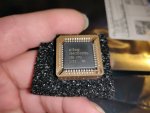DrMario
0
- Joined
- Oct 19, 2013
- Messages
- 244
- Points
- 18
I am going to make my own Zilog Z80 based computer just for sh*t and giggles while also learning about the computer history at the same time.
So yeah, I am sure this one wouldn't be the first Z80 related project that got posted here. And I am not that old. LOL But, still the computer history matters to me too.
However, I am trying to figure out if there's strict timing requirement on certain RAMs like the Everspin parallel MRAM (32 kilobytes MR256A08B MRAM with 8-bit IO) and 32 KB Fujitsu asynchronous SRAM (ie. internally clocked) as I might want to single-step through the machine codes stored thereon, kinda like old school computers which you had to input via the switches in the day the keyboards used to be elusive and hard to obtain (around 70s). I want to figure it out before I start laying things out in both CPLD flashing tool and the KiCAD so I have something that actually works.
So yeah, I am sure this one wouldn't be the first Z80 related project that got posted here. And I am not that old. LOL But, still the computer history matters to me too.
However, I am trying to figure out if there's strict timing requirement on certain RAMs like the Everspin parallel MRAM (32 kilobytes MR256A08B MRAM with 8-bit IO) and 32 KB Fujitsu asynchronous SRAM (ie. internally clocked) as I might want to single-step through the machine codes stored thereon, kinda like old school computers which you had to input via the switches in the day the keyboards used to be elusive and hard to obtain (around 70s). I want to figure it out before I start laying things out in both CPLD flashing tool and the KiCAD so I have something that actually works.





